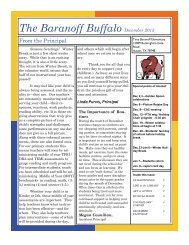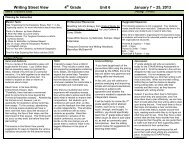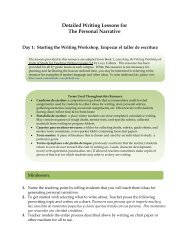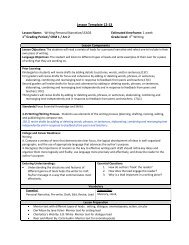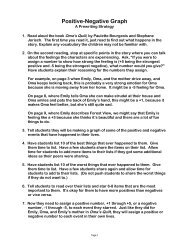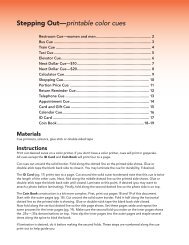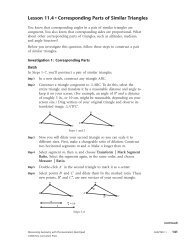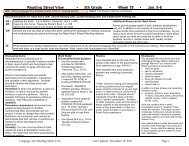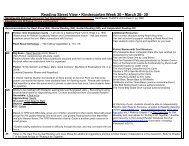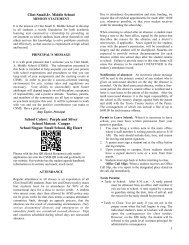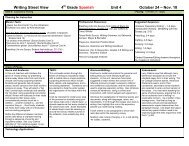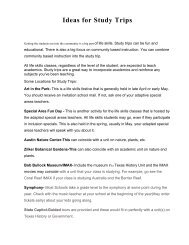7th Grade ELAR Street View
7th Grade ELAR Street View
7th Grade ELAR Street View
Create successful ePaper yourself
Turn your PDF publications into a flip-book with our unique Google optimized e-Paper software.
Best Practices (ELPS, GT, Differentiation): Extension activity which supports students at all ability levels with opportunities to read, write, speak, and listen.Developing Story Structure with Paper-Bag Skits from ReadWriteThink.org (Five 50 minute sessions to choose from). Also, consider this series of three 40-minute lessons; UsingClassic Poetry to Challenge and Enrich Students’ Writing.2012-2013 <strong>7th</strong> <strong>Grade</strong> <strong>ELAR</strong> <strong>Street</strong> <strong>View</strong> Week 15Unit: Sensory Language, Imagery, and StyleArc 2: Sensory Language and Style in Fiction (Nov. 28- Dec. 4) 5 daysTextbook Resources:Reader's Workshop: Mood and Style (HM Literature pp. 454-459)Writing Workshop: Response to Literature (p. 532)Dark They Were, and Golden-Eyed (HM Literature, p. 462) — Teachers can use thispassage to model a process for finding examples of literary elements and evidence ofthe author's style and mood.A Day's Wait (HM Literature, p. 484) — Students will use this passage for theirPerformance Task (authentic assessment) to demonstrate their understanding ofmood, style, and literary elements.Reading and Writing Connection:Students are learning about literary elements in literature, but they won't fullyunderstand them unless they can include them in their own writing.The personal narrative is easier, but the more interesting challenge is the work of fiction.Whichever the student works on, though, the teacher's expectations about the inclusionof literary elements should be made clear. Students should use metaphor, imagery,symbolism, personification, characterization, etc. Obviously they can't include ALL ofthem, but the teacher should have clear expectations for including SOME of them.Supporting Independent Reading/Connecting to the Theme:By now it should just be a class expectation (and habit) that when the teacherintroduces a literary concept, the students must find examples of that concept in theirindependent reading material. So when the teacher talks about metaphor, mood, orexamples of author’s style, the students should look back over books and storiesthey've been reading to find examples of these. When the teacher talks aboutcharacterization, the students should re-read descriptions of characters in their ownbooks. Every few days, students should write to the teacher about what they are reading (intheir Reader's Response Journal), and they should specifically and explicitly makeconnections between what they are reading and literary concepts.Fluency: The two most effective strategies for building reading fluency are (a) repeatedreading with feedback and (b) lots and lots of reading very easy and fun text. Theimportance of reading fun / easy text is often overlooked, but studies have shown thatsome struggling readers are helped by reading comic books or the newspaper comics.Students need a steady literacy diet of challenging text (part of the time) and fun / easytext (most of the time).Additional Resources:Weekly Grammar Focus:Abbreviations (p. 690, Texas Write Source)Use the Right Word 13 (p. 732, Texas Write Source)Creative Writing: Texas Write Source, pp. 361-370BrainPop Video: Mood and Tone (Username is: austinisd1, and Password is: aisd)Anchors of Support:On a large piece of butcher paper, draw an eye, nose, hand, and an ear. Challengestudents to find examples of sensory language in text (in their independent readingbooks) that corresponds to each of those 4 senses.Homework: To fit with the creative writing theme this grading period, students shouldbe given creative writing exercises for homework. For example, students could go to apublic place and describe the sensory experiences there (what do you see, hear,smell?...) Or students could take a common situation and turn it into a metaphor ("...thegiants on the field battled for control, pushing, shoving, grunting, screaming. Thelinemen squared off like tanks — immovable objects against irresistible forces)Strategies for Student Engagement:Do you call on random students when you ask questions? If so, that's good, but youmight try adding a twist to that strategy. When you ask a question, tell the students youwant ALL of them to think of an answer. Pause long enough to give them time to think,and THEN select at random the name of a student. That student should be able toanswer your question right away because you've already given him or her time to think.Is your classroom engaging? The traditional classroom arrangement (rows of studentsall facing forward) actually discourages student engagement and participation. Puttingseats in collaborative group arrangements or creating a circle so students face eachother can encourage more peer-to-peer communication while still allowing the teacherto facilitate and model for the studentsVocabulary/Word Study: Do your students have difficulty pronouncing longer,multisyllabic words? Do they just mumble over them and keep reading? Unfortunately,that's a bad habit — students should break that habit by learning to "chunk" longerwords. Try this very simple routine with your students to teach them to look for familiar"chunks" in long words.Best Practices (ELPS, GT, Differentiation):Extension and support lesson for Creative Writing in the Natural World: A Framing In this minilesson, students practice writing detailed, sensory-rich descriptions by framing a smallpiece of nature and free writing about it. From this, students can develop a variety of types of writing including poetry and short stories.English Language Arts Reading <strong>Street</strong> <strong>View</strong> Last Updated: November 7, 2012 Page 2
2012-2013 <strong>7th</strong> <strong>Grade</strong> <strong>ELAR</strong> <strong>Street</strong> <strong>View</strong> Week 16Unit: Sensory Language, Imagery, and StyleArc 3: Literary Analysis in Other Genres (Dec. 5-11) 5 daysTextbook Resources:Writing Workshop: Response to Literature (p. 556)The People Could Fly (HM Literature, p. 498)—Students can read in groups to findexamples of the author's style and the mood of the passage, metaphor, simile,imagery and other sensory language the author uses.Breaking the Ice (HM Literature, p. 512) — for a Performance Task, students canwork independently to do the same task accomplished in groups with The PeopleCould Fly.Additional Resources: Dave Barry columns and books are very popular amongyoung adults. Students love his humor and spoof books like "Dave Barry SleptHere" (a spoof on U.S. History Books) and "Dave Barry's Complete Guide to Guys."He also has written quite a few YA Fiction books including the Starcatcher seriesand Big Trouble. They are available on the Miami Herald website — students caneither read them on line, or teachers could print out several good ones for studentsto read and discuss the elements of humorous writing. His writing is especiallyappealing to young male students.(Resources listed in <strong>Street</strong><strong>View</strong> are only recommendations. Teachers may make use of other available resources tosupport instruction of TEKS.)Reading and Writing Connection: Can you have imagery in non-fiction text? Can youwrite an expository article about birds and include sensory language?Have students generate a piece of non-fiction that includes, for example—• a humorous tone, use of metaphor or simile, concrete imageryWeekly Grammar Focus: Numbers (p. 694, Texas Write Source) Use the RightWord 14 (p. 734, Texas Write Source)If teachers prefer, for the Performance Task, they can ask students to read a differentpassage of text about bullying to find examples of style, tone, and literary elements:http://www.ces.ncsu.edu/depts/fcs/pdfs/fcs505.pdfhttp://www.isafe.org/imgs/pdf/education/CyberBullying.pdfhttp://www.nasponline.org/resources/handouts/bullyingSupporting Independent Reading/Connecting to the Theme:We are compiling a list of books that even reluctant readers love. The AISDlibrarians have started this list, and we are encouraging teachers to add to it. If thereare books that you know students (even reluctant readers) get hooked on, sendinformation about those books to Dixie Huckabee.Fluency: Pump up the Volume. To get students to read more, put them in groups of 4,and give each student a DIFFERENT passage of text (something fairly short). The 4passages should be related in some way — similar theme, similar topic, similar use ofmetaphor, etc. The teacher should tell the students how they are similar (e.g. "all ofthese articles describe the problem of bullying"). On round 1, students read their article,and talk about what they learned. On round 2, they rotate, and read another article. Onround 3, they rotate again, and round 4 follows the other 3 rounds. At the end, studentsmay write a brief synopsis of what they learned about the common topic or theme.Anchors of Support: Add to the anchors of support you already have in your class toshow the students that sensory language, simile, metaphor, and other literary elementsexist in non-fiction text, too.Homework: Students can find a magazine article or a newspaper article that containsan example of a literary element they have learned about in class. Hyperbole iscommon on the sports pages. Imagery is abundant in the style section. Simile andmetaphor are everywhere if you look for it.Students must find a magazine article or a newspaper article that contains an exampleof a literary element they have learned about in class. Hyperbole is common on thesports pages. Imagery is abundant in the style section. Simile and metaphor areeverywhere if you look for it.Consider printing copies of high interest nonfiction articles from Word Generation likethis one Paying students for good grades for this homework activity, as well as, in classdeep readings to find examples of style and sensory language in nonfiction.Strategies for Student Engagement:Consider conducting a shared reading of this high interest short story called BombsAway (about a boy who takes a bomb to school for “show and tell”) by David Rice for adeep reading focus on sensory language, style, point of view, and author’s craft.Vocabulary/Word Study: Play the "Superlative Game"—Students often get confusedwith superlatives in English. Often you hear students say "more bigger" and "huger."So every week or so, play the Superlative Game. Divide the class into teams and keepscore. If you say "pretty," they have to say BOTH "prettier" and "prettiest." You canhave them spell the word for bonus points —"prettyest" is worth a point, but not a bonuspoint. As students become more sophisticated, you can challenge them to come upwith "synonym superlatives" — teacher says "prettiest" and students say "mostbeautiful" or "most attractive" or "fairest of them all!"Best Practices (ELPS, GT, Differentiation):Extension Lesson Unit: Comparing Portrayals of Slavery in Nineteenth-Century Photography and Literature In this lesson, students use a Venn Diagram to compare and contrastMark Twain’s novel and excerpts from Frederick Doulgass’ narrative to original photographs of slaves from the late-nineteenth century. Then they write an essay to compare thedifferent portrayals, arguing to what extent art can reliably reflect truth. In addition, they will discuss art as social commentary.English Language Arts Reading <strong>Street</strong> <strong>View</strong> Last Updated: November 7, 2012 Page 3
2012-2013 <strong>7th</strong> <strong>Grade</strong> <strong>ELAR</strong> <strong>Street</strong> <strong>View</strong> Week 17 & 18Unit: Sensory Language, Imagery, and StyleArc 4: Developing a Style and Using literary Elements in Writing (Dec. 12-20) 7 daysTextbook Resources:Writing Workshop: Personal Narrative (HM Literature, p. 880)Writing Workshop: Short Story (HM Literature, p. 432)Reading and Writing Connection:Students should be finishing their creative writing project. This last week or two beforewinter break is a great time to have them revise, polish, and present their project.The teacher may want to compile writing by students into an anthology — it would makea great Christmas gift!Presentations are a great time to practice fluency. Students can practice giving apresentation over and over until their presentation is smooth and polished. Repeatedlyreading their own writing is a great way for students to build fluency whilesimultaneously developing a more engaging and interesting writing style.Weekly Grammar Focus:Prepositions (p. 554, Texas Write Source)Use the Right Word 15 (p. 736, Texas Write Source)Supporting Independent Reading/Connecting to the Theme:The holidays are for children, and students in middle school can get just as nostalgic asthe rest of us. Give students a chance to read classic Christmas stories—stories theyloved when they were younger. But don't let them off the hook — they still have to findexamples of characterization, metaphor, personification, etc.You're a mean one, Mr. Grinch.You really are a heel.You're as cuddly as a cactus,You're as charming as an eel.Mr. Grinch.Additional Resources:On-line sample lesson for creative writing to develop a mood.(Resources listed in <strong>Street</strong><strong>View</strong> are only recommendations. Teachers may make use of other available resources to supportinstruction of TEKS.)Anchors of Support: Students could create anchors of support by finding examples ofsensory language, personification, simile, metaphor, and other literary elements in classicChristmas stories. They could copy them onto butcher paper and post them around theroom.Homework:The teacher should be assigning specific tasks related to the creative writing exercise thatstudents are finishing.What is the nuance? Students should understand that not all synonyms areinterchangeable. The sentence "The girl is sad" has a different connotation than thesentence "The girl is morose" or "anguished" or "tormented." Have students reserve asection in their vocabulary journal to describe synonyms and their different connotations.Strategies for Student Engagement: What kind of feedback do you give your students?Limited or no feedback from the teacher often leads to students withdrawing or "checkingout" of a class. But feedback that stimulates a dialog, encourages a response, anddemands a higher level of performance encourages most students to keep striving forimprovement. If you care enough to take the time to give them thoughtful feedback, yourstudents will care enough to work harder to earn your respect.Are your questions conversation killers? When teachers watch recordings of their ownlessons, they often realize that the questions they are asking their students are fairly"surface-level" questions. Some teachers are even horrified to see themselves asking fillin-the-blankquestions that bring Ferris Bueller to mind: "And that's why this is referred toas the .... anybody? ... anybody?"This type of questioning is actually normal — most teachers do this — but it does indicatea lack of planning and preparation. Even the best teachers must plan their questions inadvance so they don't fall in the trap of asking simple and boring questions.Question StartersQuestioning ToolkitFluency: Even if students are reading a lot of fun / easy text every day, they should stillpractice repeatedly reading text for an audience (with feedback after each reading).They say that practice makes perfect, but direct instruction makes perfect happen muchfaster. As a regular routine, students should read a short passage of text (about 100words) aloud to another student or a teacher 3 to 4 times. And some feedback shouldbe given after each reading. Fluency Lessons and Activities from FCRRVocabulary/Word Study: Students really don't remember new vocabulary words verywell until they have to use them (in speech and in writing). Create a system for "activeuse" of the vocabulary you have taught. It can be as simple as a mandate (In every essay,students must appropriately use at least 3 of the vocabulary words they have learned thisyear.) Be creative and come up with a class system for encouraging active use ofvocabulary.Best Practices (ELPS, GT, Differentiation) Consider having students create themed and descriptive cookbook entries, postcards from their culture during the winter holidaythey celebrate, explanations with illustrations of various holiday traditions using sensory language, almost persuading and luring readers to want to try their recipe, traditions, orcelebrations. Consider creating and having word banks and sentence starters for ELL’s. Have students complete this work on 4X6 postcards and couch this activity as a “when youhave finished other activities” idea. Share and post all submissions for pre-holiday viewing. Critical Thinking/Performance Tasks for differentiated and deep processing opportunities.English Language Arts Reading <strong>Street</strong> <strong>View</strong> Last Updated: November 7, 2012 Page 4



